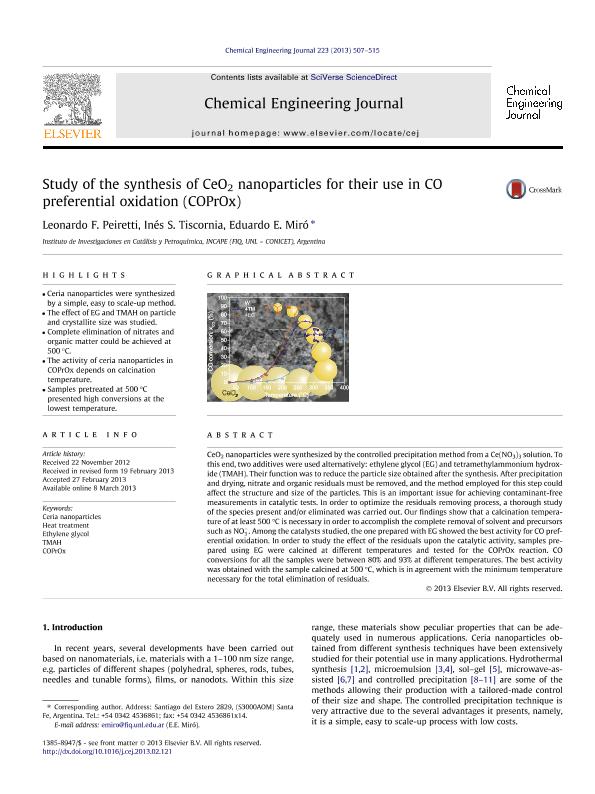Artículo
Study of the synthesis of CeO2 nanoparticles for their use in CO preferential oxidation (COPrOx)
Fecha de publicación:
03/2013
Editorial:
Elsevier
Revista:
Chemical Engineering Journal
ISSN:
1385-8947
Idioma:
Inglés
Tipo de recurso:
Artículo publicado
Clasificación temática:
Resumen
CeO2 nanoparticles were synthesized by the controlled precipitation method from a Ce(NO3)3 solution. To this end, two additives were used alternatively: ethylene glycol (EG) and tetramethylammonium hydroxide (TMAH). Their function was to reduce the particle size obtained after the synthesis. After precipitation and drying, nitrate and organic residuals must be removed, and the method employed for this step could affect the structure and size of the particles. This is an important issue for achieving contaminant-free measurements in catalytic tests. In order to optimize the residuals removing process, a thorough study of the species present and/or eliminated was carried out. Our findings show that a calcination temperature of at least 500 C is necessary in order to accomplish the complete removal of solvent and precursors such as NO 3 . Among the catalysts studied, the one prepared with EG showed the best activity for CO preferential oxidation. In order to study the effect of the residuals upon the catalytic activity, samples prepared using EG were calcined at different temperatures and tested for the COPrOx reaction. CO conversions for all the samples were between 80% and 93% at different temperatures. The best activity was obtained with the sample calcined at 500 C, which is in agreement with the minimum temperature necessary for the total elimination of residuals.
Palabras clave:
Ceria Nanoparticles
,
Heat Treatment
,
Ethylene Glycol
,
Coprox
,
Tmah
Archivos asociados
Licencia
Identificadores
Colecciones
Articulos(INCAPE)
Articulos de INST.DE INVEST.EN CATALISIS Y PETROQUIMICA "ING. JOSE MIGUEL PARERA"
Articulos de INST.DE INVEST.EN CATALISIS Y PETROQUIMICA "ING. JOSE MIGUEL PARERA"
Citación
Peiretti, Leonardo Federico; Tiscornia, Ines Silvia; Miro, Eduardo Ernesto; Study of the synthesis of CeO2 nanoparticles for their use in CO preferential oxidation (COPrOx); Elsevier; Chemical Engineering Journal; 223; 3-2013; 507-515
Compartir
Altmétricas




